Studynerdz.com (spam) - Aug 2021 update
Studynerdz.com Removal Guide
What is Studynerdz.com?
Studynerdz.com is a questionable site that aims to trick people into subscribing to push notifications
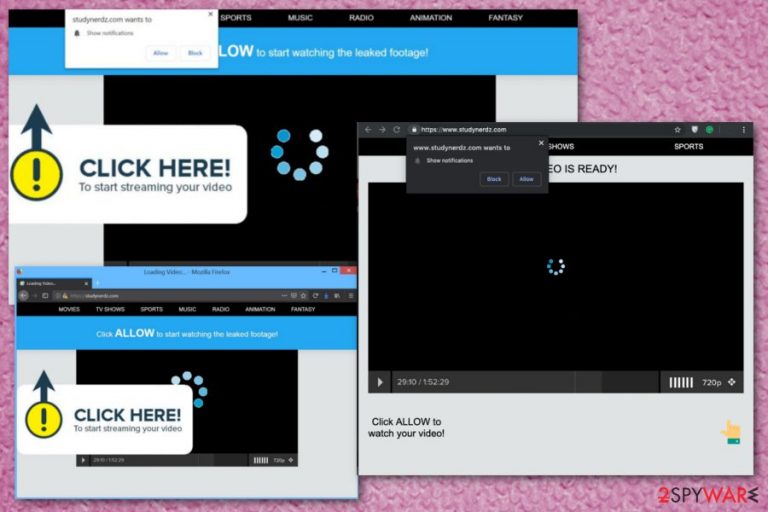
Studynerdz.com is the website that users can encounter at any time during their browsing sessions on Google Chrome, Safari, Mozilla Firefox, Internet Explorer, or any other browsers. The page is designed in order to make users allow notifications to be shown, and, once agreed, they will be faced with intrusive pop-ups, banners, deals, offers, flashing windows, and other intrusive content to be displayed directly on their desktops.
The reason users see annoying Studynerdz.com notifications is due to adware[1] infection. These potentially unwanted programs usually travel within software bundles and, because users often furry installation processes of freeware, often end up with additional components without notice.
Adware is designed to redirect users to sponsored content, which grants third parties profits. However, the sites that users are rerouted to might not always be reliable, and sometimes even dangerous. Additionally, PUPs are known for tracking users' web browsing data, which might also occasionally include personal information. All the gathered details might be later used for targeted advertising or even in malvertising campaigns.[2]
| Name | Studynerdz.com |
|---|---|
| Type | Adware |
| Category | Potentially unwanted program[3] |
| Symptoms | Lots of redirects, advertisements that expose to malicious content and encourage to subscribe to additional content |
| Distribution | Software installations, deceptive sites, advertisements |
| Main danger | Exposes to malicious material, installs unwanted programs and browser extensions, tracks users' data and shares that with third-party advertisers |
| Removal | Use a reputable anti-malware and scan the machine thoroughly to remove the PUP to stop these intrusive pop up ads |
| Recovery | Make sure you use FortectIntego after you reset the affected web browser to help with affected or corrupted files in the system |
While Studynerdz.com redirects are most likely caused by a potentially unwanted program lurking in the computer system, it might not necessarily be the case. Users can end up on the domain after being redirected from another malicious page. Nevertheless, the best way to make sure is to scan your computer is the anti-virus software.
Initially, the website is not a harmful cyber threat, but it affects more than your Google Chrome, Internet Explorer, or Mozilla Firefox. Although the most noticeable feature of this intruder is browser redirects, notifications, and pop-up ads to remain running on the system continuously, the PUP alters Windows registry keys.
Adware typically does not modify system files, such as the registry.[4] However, it usually makes changes to the installed browsers instead, which consequently allows unwanted activity, such as redirects to Studynerdz.com or other suspicious sites.
The pop-up message that the page delivers:
Studynerdz.com wants to Show notifications
Press tap the Allow button to continue
Such advertising domain often gets called a virus or malicious because it creates frustration with its symptoms and unwanted content. When this domain triggers various redirects that can lead to infiltration of other viruses because the user might be exposed to malware-spreading URLs or other possibly harmful material.
You should immediately think about Studynerdz.com removal, so you can avoid additional infiltrations or malware, although it may be difficult due to other files and programs. Experts[5] advise using reputable AV tools for that because only tools like SpyHunter 5Combo Cleaner or Malwarebytes can ensure full threat removal.

Studynerdz.com is one of many potentially unwanted programs that spread around using deceptive techniques like software bundling. You could have installed a video converter or some free applications, and this is the reason why redirects fill up your screen.
The PUP is not supposed to infect your machine with malware but simply redirects you to different pages and show intrusive commercial content. Unfortunately, visiting these pages leads to adware campaigns and spam tools that trick you into purchasing some tools and programs from advertisements.
Note that various intruders that are based on web browsing activities, including the Studynerdz.com adware, also installs browser content besides changing notification preferences and other settings. So you need to check that content and remove questionable content from Chrome, Firefox, or any other browsers.
Remove unwanted notifications from Google Chrome (desktop):
- Open Google Chrome browser and go to Menu > Settings.
- Scroll down and click on Advanced.
- Locate Privacy and security section and pick Site Settings > Notifications.
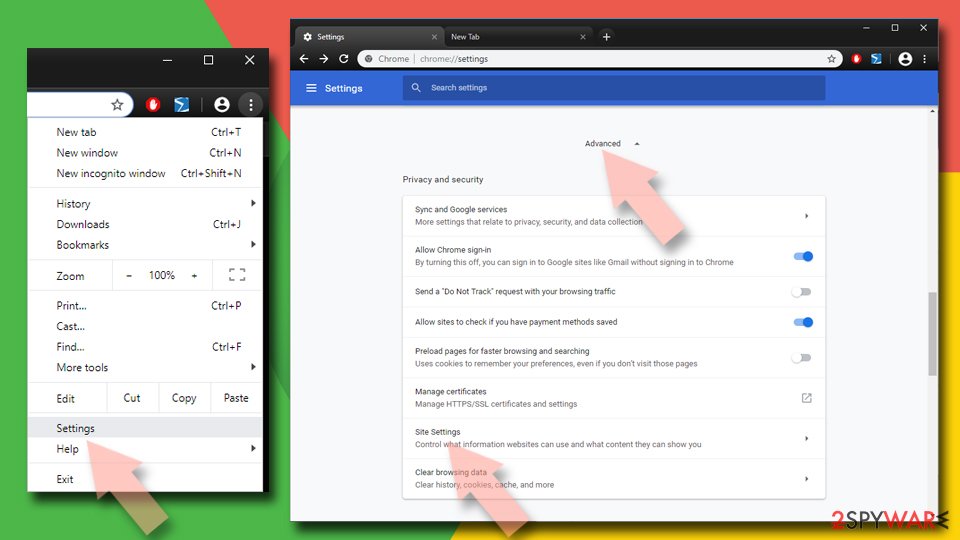
- Look at the Allow section and look for a suspicious URL.
- Click the three vertical dots next to it and pick Block. This should remove unwanted notifications from Google Chrome.
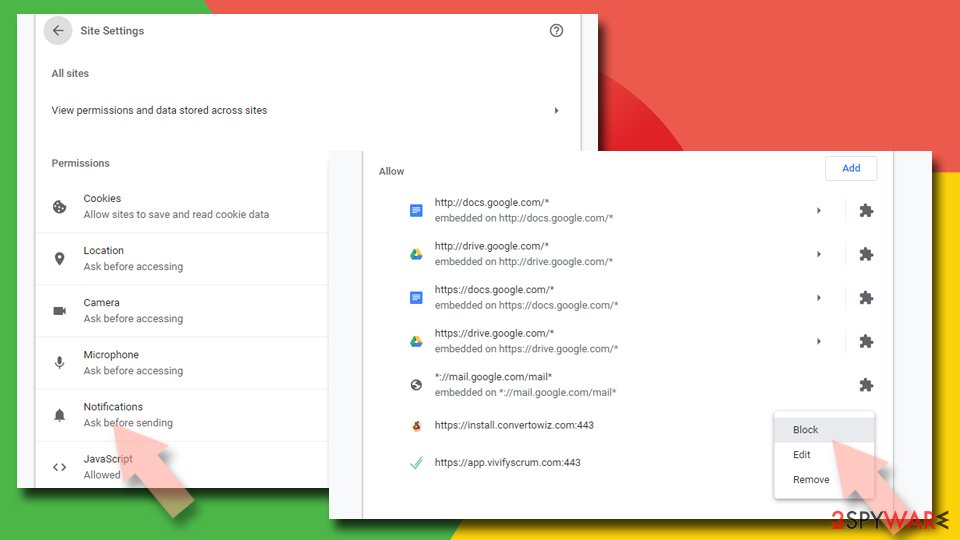
Remove unwanted notifications from Google Chrome (Android):
- Open Google Chrome and tap on Settings (three vertical dots).
- Select Notifications.
- Scroll down to Sites section.
- Locate the unwanted URL and toggle the button to the left (Off setting).
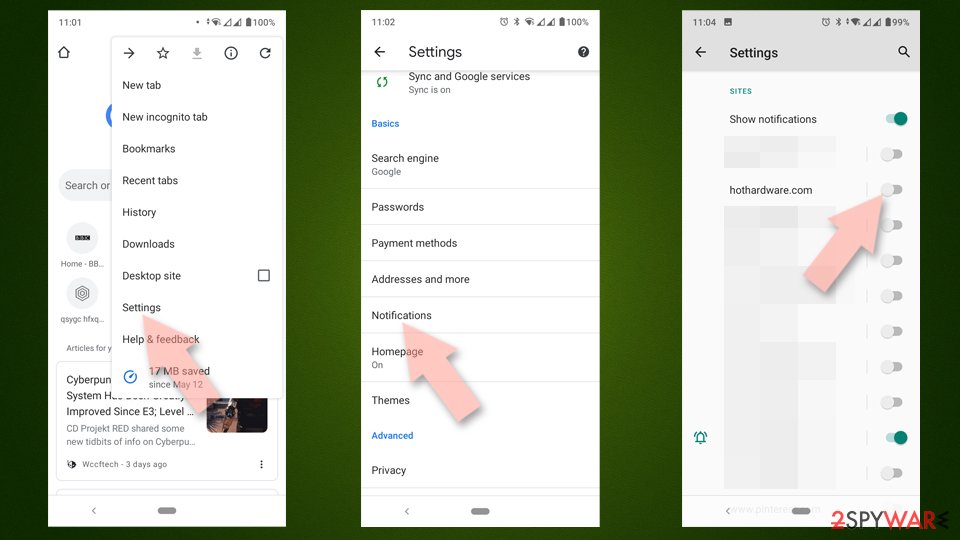
Remove unwanted notifications from Mozilla Firefox:
- Open Mozilla Firefox and go to Menu > Options.
- Click on Privacy & Security section.
- Under Permissions, you should be able to see Notifications. Click Settings button next to it.
- In the Settings – Notification Permissions window, click on the drop-down menu by the URL in question.
- Select Block and then click on Save Changes. This should remove unwanted notifications from Mozilla Firefox.
Remove unwanted notifications from Safari:
- Click on Safari > Preferences…
- Go to Websites tab and, under General, select Notifications.
- Select the web address in question, click the drop-down menu and select Deny.
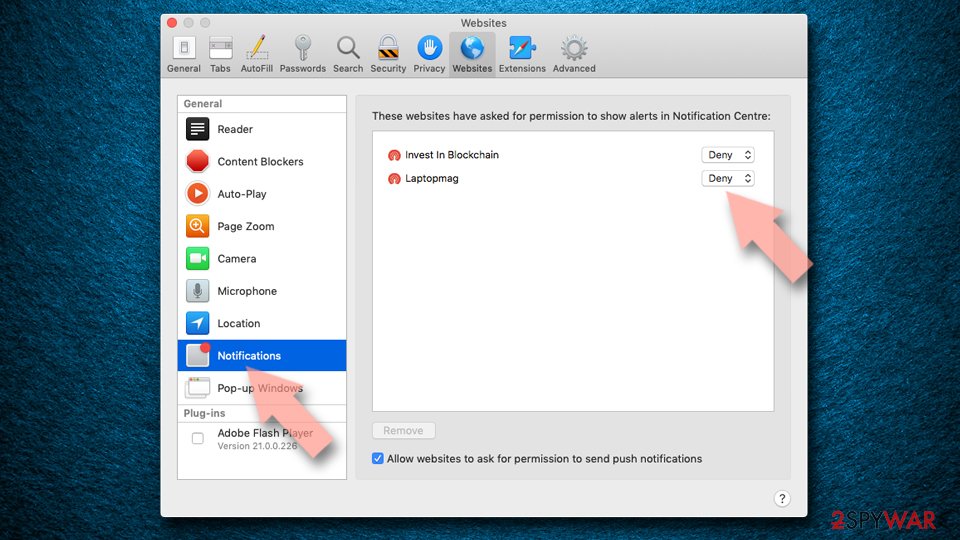
Remove unwanted notifications from MS Edge:
- Open Microsoft Edge, and click the Settings and more button (three horizontal dots) at the top-right of the window.
- Select Settings and then go to Advanced.
- Under Website permissions, pick Manage permissions and select the URL in question.

- Toggle the switch to the left to turn notifications off on Microsoft Edge.
Remove unwanted notifications from MS Edge (Chromium):
- Open Microsoft Edge, and go to Settings.
- Select Site permissions.
- Go to Notifications on the right.
- Under Allow, you will find the unwanted entry.
- Click on More actions and select Block.
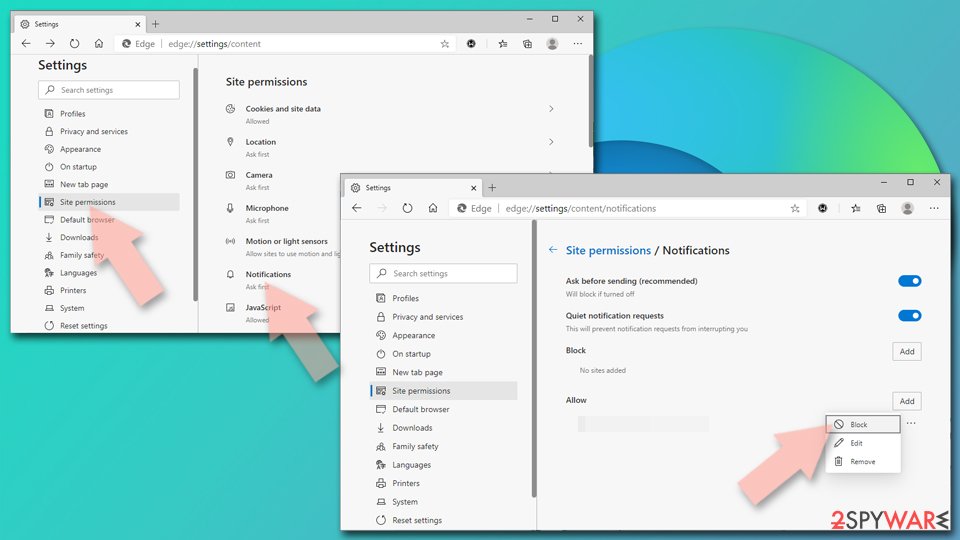
Remove unwanted notifications from Internet Explorer:
- Open Internet Explorer, and click on the Gear icon at the top-right on the window.
- Select Internet options and go to Privacy tab.
- In the Pop-up Blocker section, click on Settings.
- Locate web address in question under Allowed sites and pick Remove.
However, when it comes to proper cyber infection removal manual methods are not recommended because you need to find all associated files and programs to end the adware ultimately. This is a job that a professional anti-malware program can do. Remove the infection using an anti-malware tool and scan the system entirely. FortectIntego should be used further to check the system for virus damage and changes made by the adware. More tips are given at the end of this post.
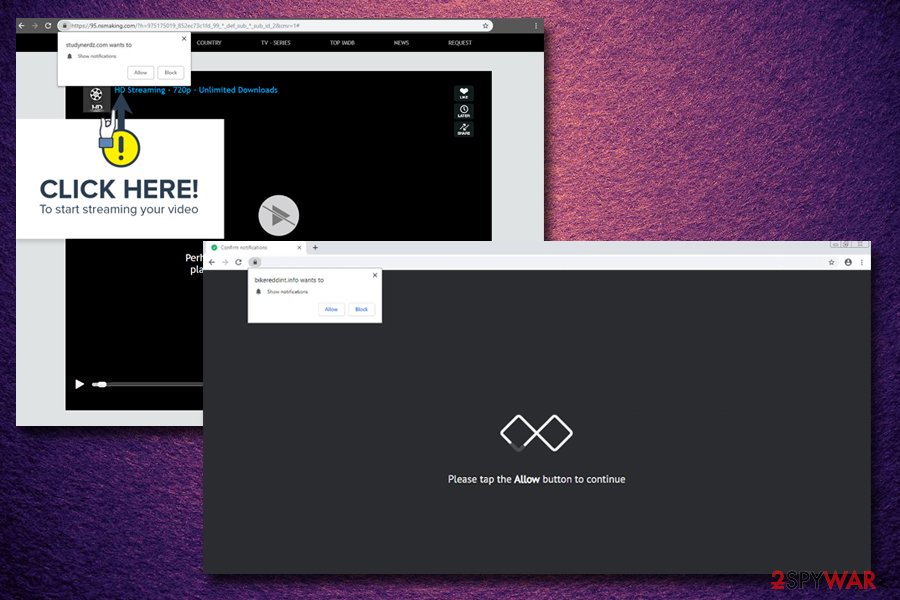
Do to hesitate when you see suspicious material online – avoid it
When you use questionable sources for your freeware or software updates, P2P services, or non-official providers, you risk infecting your machine with PUPs, as they often travel in software bundles. Third-party software installers come with pre-packed applications and automatically distributes useless content.
When you choose to skip through some steps during installations and opt for Default or Quick processes you get all included programs installed with other software. You can unpack those programs by choosing Advanced or Custom installations and de-selecting apps you don't need manually.
This unpacking of anything additive should occur without any prior notification if you choose the right installation method. Otherwise, all programs get to your machine without any additional permission requirement.
You can also avoid these cyber infections by keeping the AV tool up-to-date, so it blocks questionable content and keeps you from visiting possibly malicious sites in advance. Get a reputable anti-malware and keep it running on the system.
Get rid of the application fully to end all the Studynerdz.com behavior
Follow-step-by-step guide below the article to remove Studynerdz.com and reverse all the changes this adware has made on the machine. You may need to manually check all web browsers you own and use to make sure there are no traces left.
Allow the professional anti-malware of your choosing to perform an automatic PUP removal and clean the device fully. Then you can get back to browsing online freely and, most importantly, safely. There are no reasons to hesitate because keeping the intruder active can lead to further damage and issues with the system.
You may remove virus damage with a help of FortectIntego. SpyHunter 5Combo Cleaner and Malwarebytes are recommended to detect potentially unwanted programs and viruses with all their files and registry entries that are related to them.
Getting rid of Studynerdz.com. Follow these steps
Uninstall from Windows
Instructions for Windows 10/8 machines:
- Enter Control Panel into Windows search box and hit Enter or click on the search result.
- Under Programs, select Uninstall a program.

- From the list, find the entry of the suspicious program.
- Right-click on the application and select Uninstall.
- If User Account Control shows up, click Yes.
- Wait till uninstallation process is complete and click OK.

If you are Windows 7/XP user, proceed with the following instructions:
- Click on Windows Start > Control Panel located on the right pane (if you are Windows XP user, click on Add/Remove Programs).
- In Control Panel, select Programs > Uninstall a program.

- Pick the unwanted application by clicking on it once.
- At the top, click Uninstall/Change.
- In the confirmation prompt, pick Yes.
- Click OK once the removal process is finished.
Delete from macOS
Remove items from Applications folder:
- From the menu bar, select Go > Applications.
- In the Applications folder, look for all related entries.
- Click on the app and drag it to Trash (or right-click and pick Move to Trash)

To fully remove an unwanted app, you need to access Application Support, LaunchAgents, and LaunchDaemons folders and delete relevant files:
- Select Go > Go to Folder.
- Enter /Library/Application Support and click Go or press Enter.
- In the Application Support folder, look for any dubious entries and then delete them.
- Now enter /Library/LaunchAgents and /Library/LaunchDaemons folders the same way and terminate all the related .plist files.

Remove from Microsoft Edge
Delete unwanted extensions from MS Edge:
- Select Menu (three horizontal dots at the top-right of the browser window) and pick Extensions.
- From the list, pick the extension and click on the Gear icon.
- Click on Uninstall at the bottom.
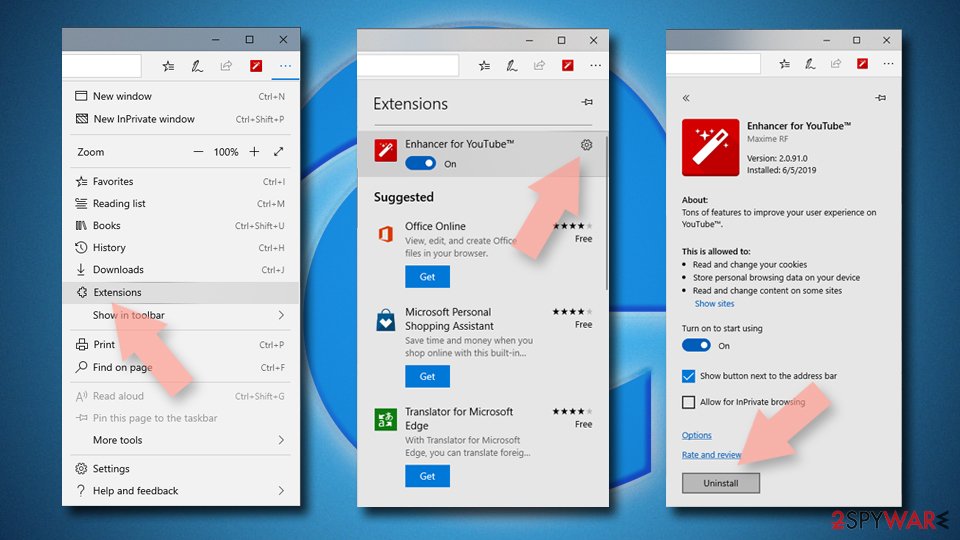
Clear cookies and other browser data:
- Click on the Menu (three horizontal dots at the top-right of the browser window) and select Privacy & security.
- Under Clear browsing data, pick Choose what to clear.
- Select everything (apart from passwords, although you might want to include Media licenses as well, if applicable) and click on Clear.
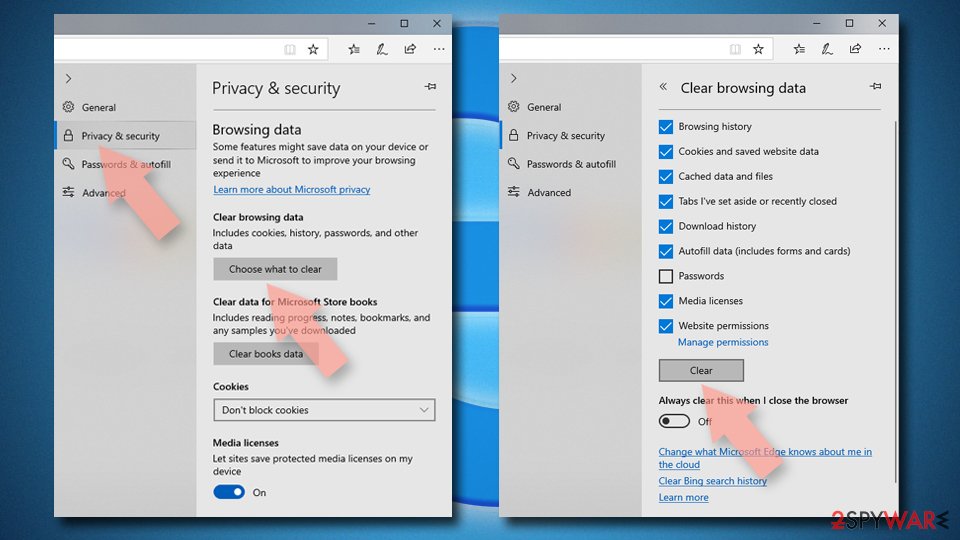
Restore new tab and homepage settings:
- Click the menu icon and choose Settings.
- Then find On startup section.
- Click Disable if you found any suspicious domain.
Reset MS Edge if the above steps did not work:
- Press on Ctrl + Shift + Esc to open Task Manager.
- Click on More details arrow at the bottom of the window.
- Select Details tab.
- Now scroll down and locate every entry with Microsoft Edge name in it. Right-click on each of them and select End Task to stop MS Edge from running.
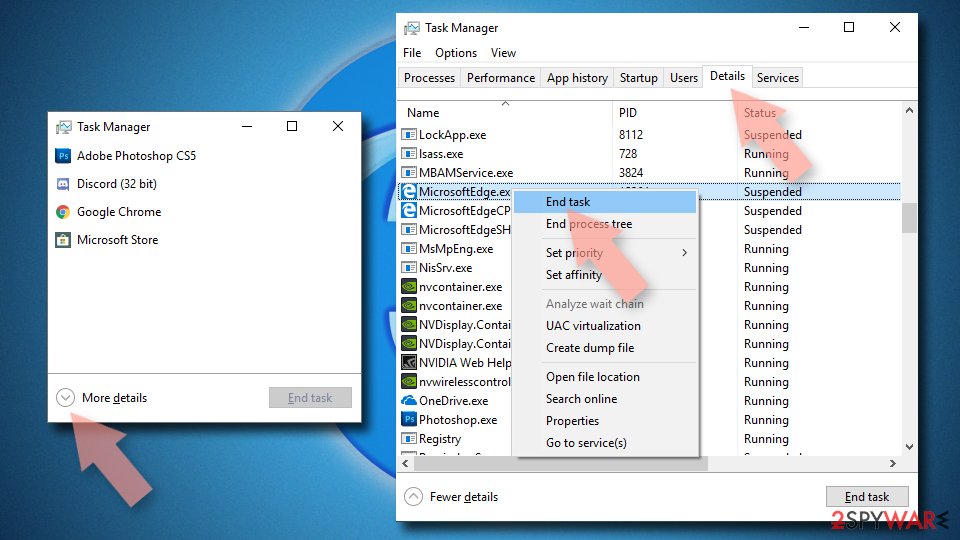
If this solution failed to help you, you need to use an advanced Edge reset method. Note that you need to backup your data before proceeding.
- Find the following folder on your computer: C:\\Users\\%username%\\AppData\\Local\\Packages\\Microsoft.MicrosoftEdge_8wekyb3d8bbwe.
- Press Ctrl + A on your keyboard to select all folders.
- Right-click on them and pick Delete

- Now right-click on the Start button and pick Windows PowerShell (Admin).
- When the new window opens, copy and paste the following command, and then press Enter:
Get-AppXPackage -AllUsers -Name Microsoft.MicrosoftEdge | Foreach {Add-AppxPackage -DisableDevelopmentMode -Register “$($_.InstallLocation)\\AppXManifest.xml” -Verbose

Instructions for Chromium-based Edge
Delete extensions from MS Edge (Chromium):
- Open Edge and click select Settings > Extensions.
- Delete unwanted extensions by clicking Remove.
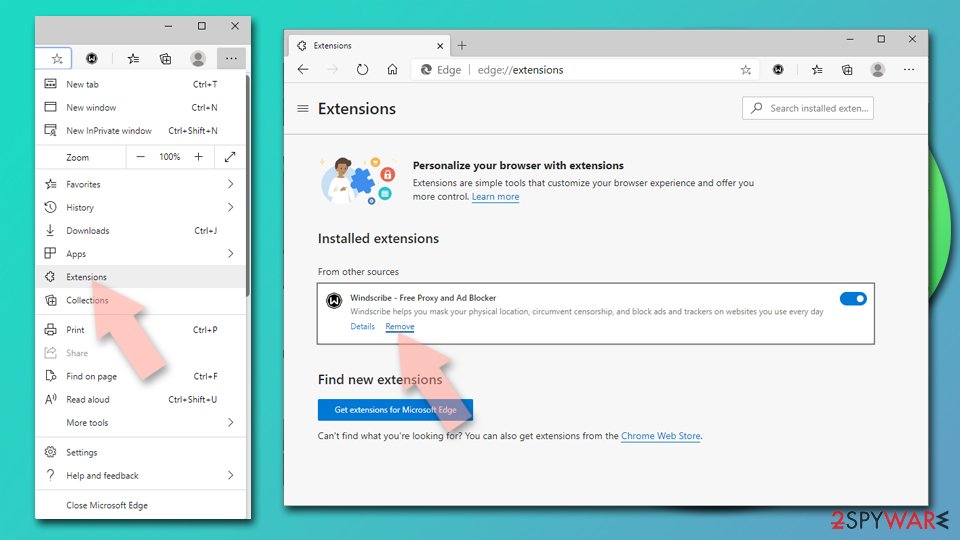
Clear cache and site data:
- Click on Menu and go to Settings.
- Select Privacy, search and services.
- Under Clear browsing data, pick Choose what to clear.
- Under Time range, pick All time.
- Select Clear now.
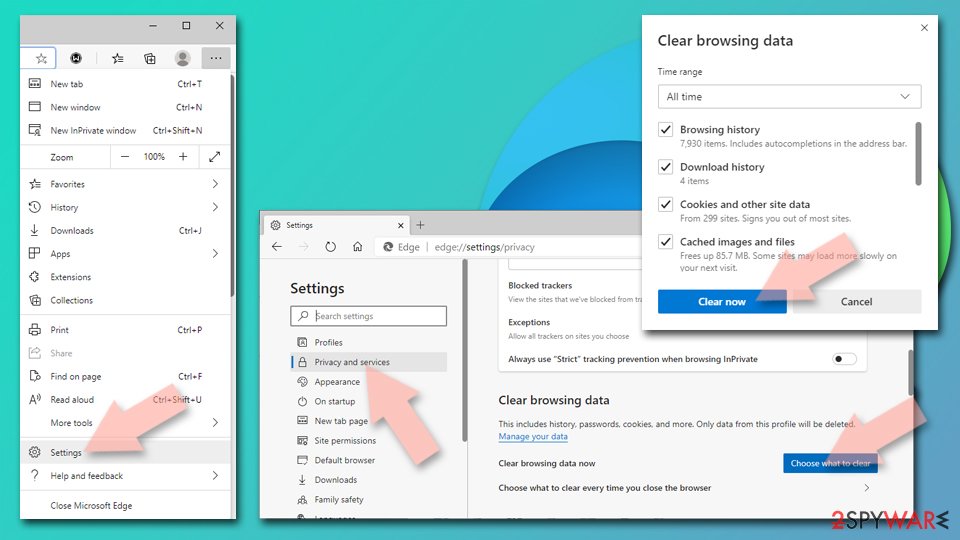
Reset Chromium-based MS Edge:
- Click on Menu and select Settings.
- On the left side, pick Reset settings.
- Select Restore settings to their default values.
- Confirm with Reset.
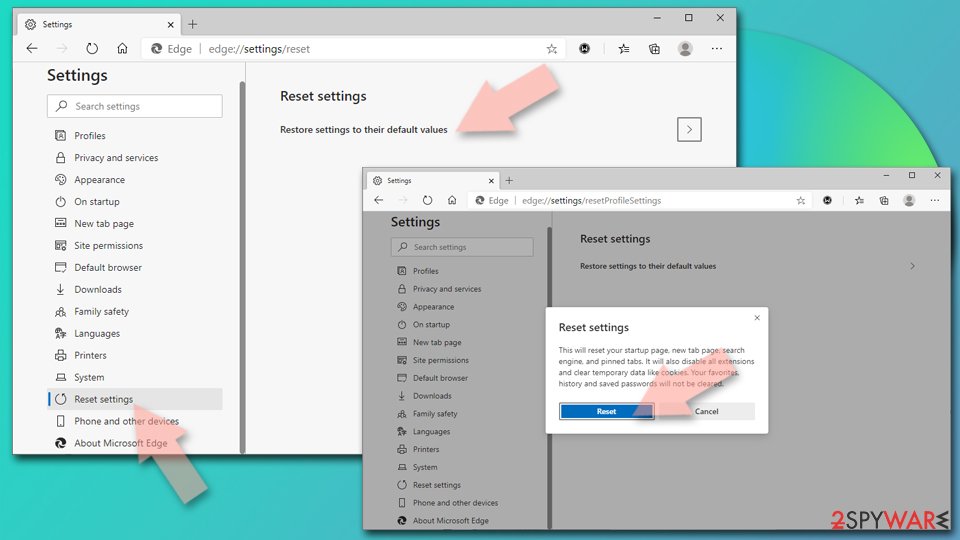
Remove from Mozilla Firefox (FF)
Remove dangerous extensions:
- Open Mozilla Firefox browser and click on the Menu (three horizontal lines at the top-right of the window).
- Select Add-ons.
- In here, select unwanted plugin and click Remove.

Reset the homepage:
- Click three horizontal lines at the top right corner to open the menu.
- Choose Options.
- Under Home options, enter your preferred site that will open every time you newly open the Mozilla Firefox.
Clear cookies and site data:
- Click Menu and pick Settings.
- Go to Privacy & Security section.
- Scroll down to locate Cookies and Site Data.
- Click on Clear Data…
- Select Cookies and Site Data, as well as Cached Web Content and press Clear.
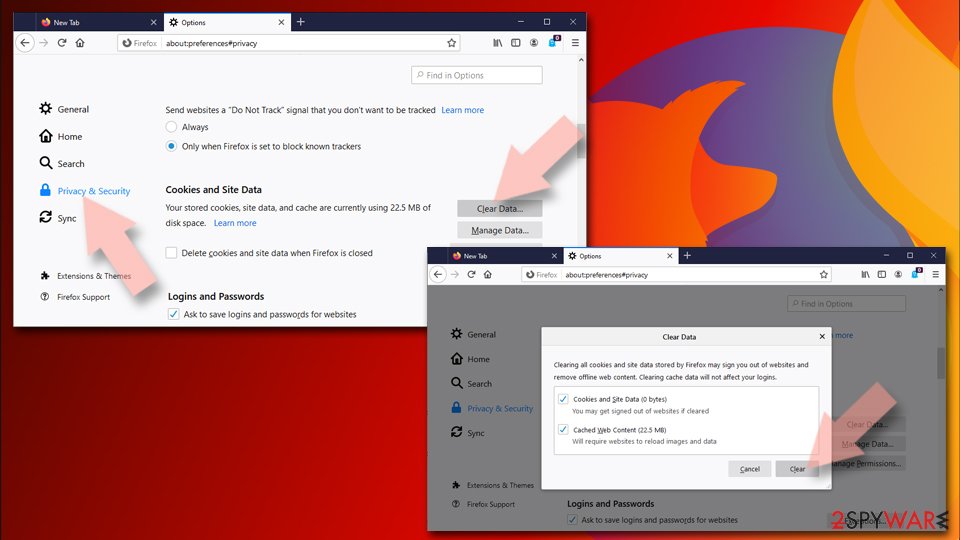
Reset Mozilla Firefox
If clearing the browser as explained above did not help, reset Mozilla Firefox:
- Open Mozilla Firefox browser and click the Menu.
- Go to Help and then choose Troubleshooting Information.
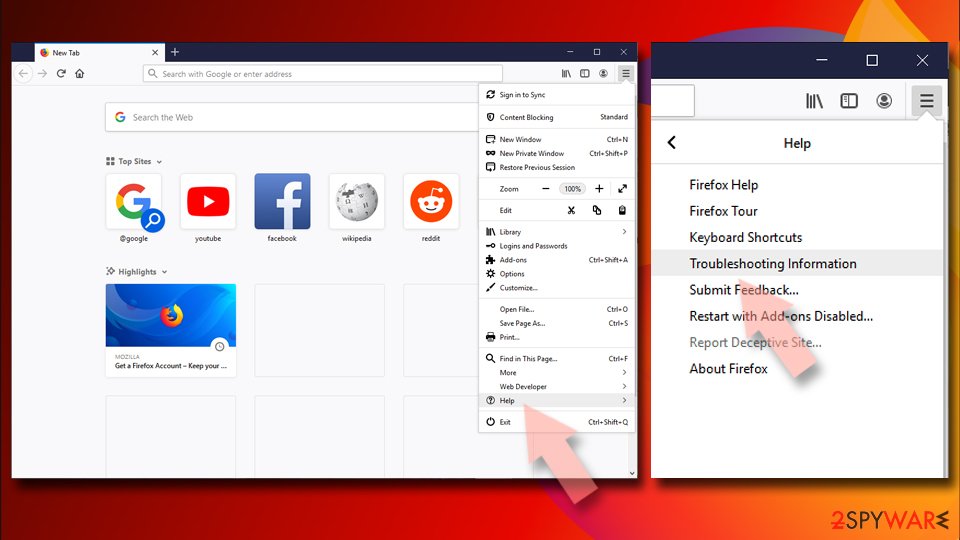
- Under Give Firefox a tune up section, click on Refresh Firefox…
- Once the pop-up shows up, confirm the action by pressing on Refresh Firefox.
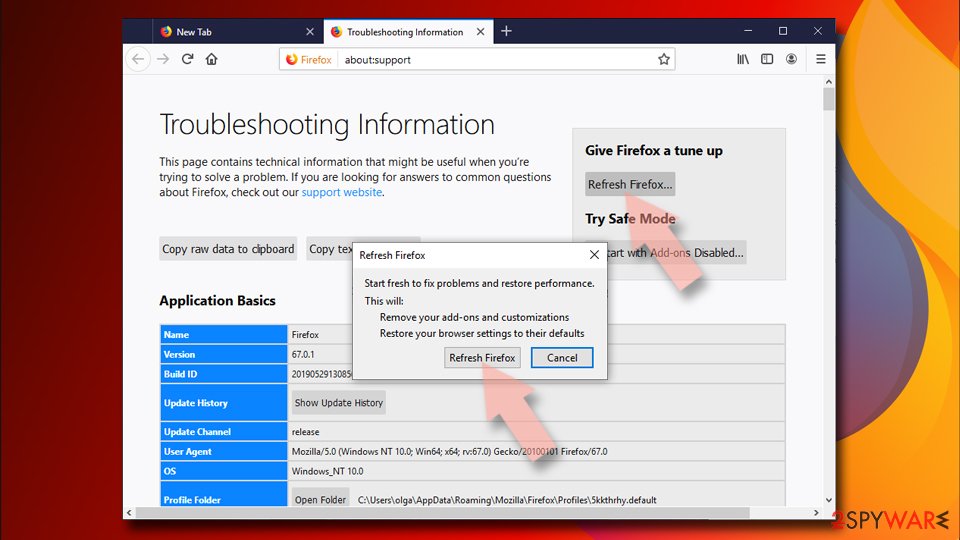
Remove from Google Chrome
Delete malicious extensions from Google Chrome:
- Open Google Chrome, click on the Menu (three vertical dots at the top-right corner) and select More tools > Extensions.
- In the newly opened window, you will see all the installed extensions. Uninstall all the suspicious plugins that might be related to the unwanted program by clicking Remove.

Clear cache and web data from Chrome:
- Click on Menu and pick Settings.
- Under Privacy and security, select Clear browsing data.
- Select Browsing history, Cookies and other site data, as well as Cached images and files.
- Click Clear data.

Change your homepage:
- Click menu and choose Settings.
- Look for a suspicious site in the On startup section.
- Click on Open a specific or set of pages and click on three dots to find the Remove option.
Reset Google Chrome:
If the previous methods did not help you, reset Google Chrome to eliminate all the unwanted components:
- Click on Menu and select Settings.
- In the Settings, scroll down and click Advanced.
- Scroll down and locate Reset and clean up section.
- Now click Restore settings to their original defaults.
- Confirm with Reset settings.
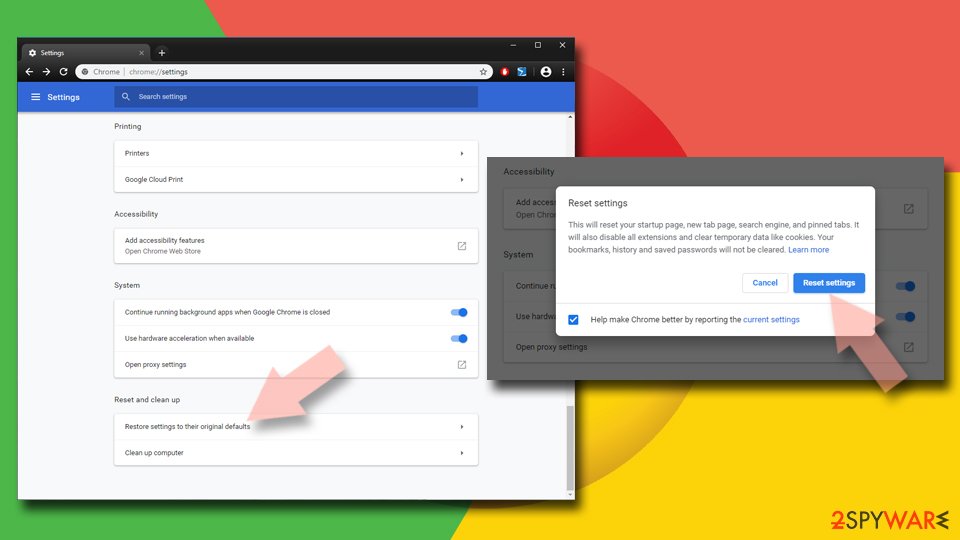
Delete from Safari
Remove unwanted extensions from Safari:
- Click Safari > Preferences…
- In the new window, pick Extensions.
- Select the unwanted extension and select Uninstall.
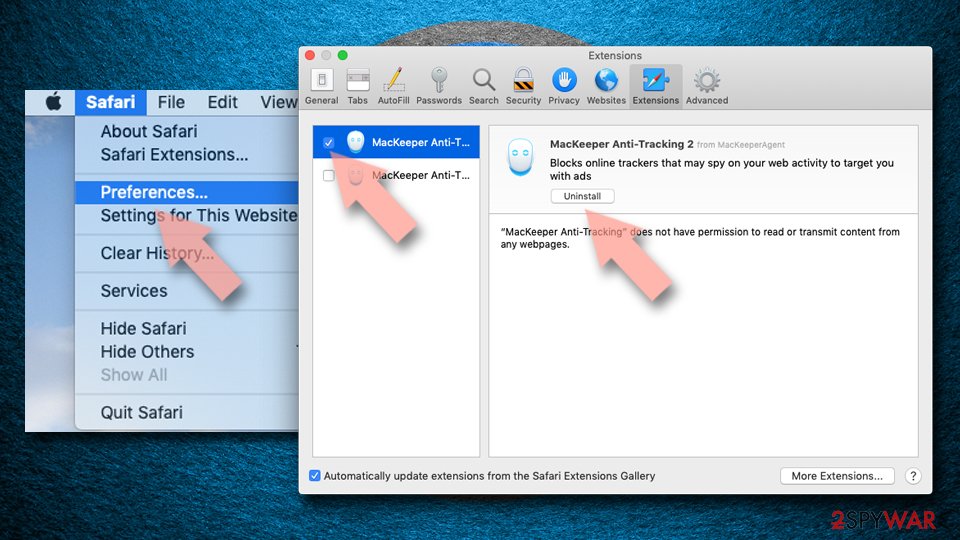
Clear cookies and other website data from Safari:
- Click Safari > Clear History…
- From the drop-down menu under Clear, pick all history.
- Confirm with Clear History.
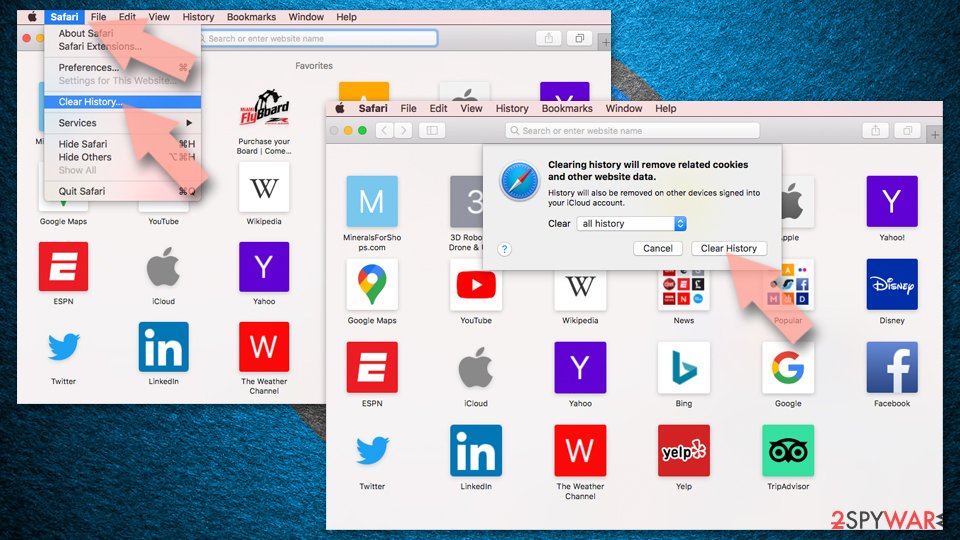
Reset Safari if the above-mentioned steps did not help you:
- Click Safari > Preferences…
- Go to Advanced tab.
- Tick the Show Develop menu in menu bar.
- From the menu bar, click Develop, and then select Empty Caches.
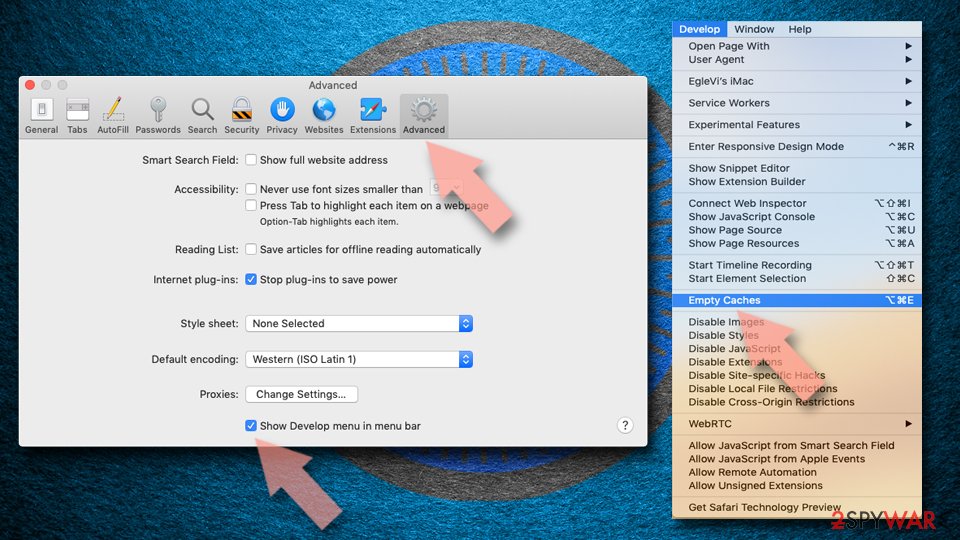
After uninstalling this potentially unwanted program (PUP) and fixing each of your web browsers, we recommend you to scan your PC system with a reputable anti-spyware. This will help you to get rid of Studynerdz.com registry traces and will also identify related parasites or possible malware infections on your computer. For that you can use our top-rated malware remover: FortectIntego, SpyHunter 5Combo Cleaner or Malwarebytes.
How to prevent from getting adware
Protect your privacy – employ a VPN
There are several ways how to make your online time more private – you can access an incognito tab. However, there is no secret that even in this mode, you are tracked for advertising purposes. There is a way to add an extra layer of protection and create a completely anonymous web browsing practice with the help of Private Internet Access VPN. This software reroutes traffic through different servers, thus leaving your IP address and geolocation in disguise. Besides, it is based on a strict no-log policy, meaning that no data will be recorded, leaked, and available for both first and third parties. The combination of a secure web browser and Private Internet Access VPN will let you browse the Internet without a feeling of being spied or targeted by criminals.
No backups? No problem. Use a data recovery tool
If you wonder how data loss can occur, you should not look any further for answers – human errors, malware attacks, hardware failures, power cuts, natural disasters, or even simple negligence. In some cases, lost files are extremely important, and many straight out panic when such an unfortunate course of events happen. Due to this, you should always ensure that you prepare proper data backups on a regular basis.
If you were caught by surprise and did not have any backups to restore your files from, not everything is lost. Data Recovery Pro is one of the leading file recovery solutions you can find on the market – it is likely to restore even lost emails or data located on an external device.
- ^ Margaret Rouse. Adware. SearchSecurity. Information Security information, news and tips.
- ^ Malvertising. Wikipedia. The free encyclopedia.
- ^ Martin Brinkmann. How to enable Windows Defender's potentially unwanted programs protection. Ghacks. Technology news.
- ^ Tim Fisher. What Is the Windows Registry?. Lifewire. Tech untangled.
- ^ LesVirus. LesVirus. Spyware related news.
